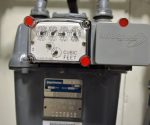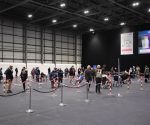Fishmongers Hall Attack Inquest opens to explain that Usman Khan did sit up after being shot, after all
The much anticipated inquests into the deaths occurring during the 2019 Fishmongers Hall “terror” incident began yesterday (12th April), and the first big surprise was the location of the hearings. Due to have taken place at the Old Bailey, proceedings instead went ahead at the City of London’s Guildhall. Putting the change of setting down to coping with the pretend pandemic (the coronahoax), maybe the staging of the inquest at the very seat of real power in the UK is actually an indication of the need to exert very tight control over what could be the loosest cannon in the history of these types of attack. At the last time of checking, the families of the two victims – at least their legal representation – were concerned that the deaths constituted violations of human rights, and that UK Government was culpable.
Interestingly, instead of providing the usual victim character portrait which tends to lament the demise of the person in question, and which this sort of inquest clearly uses to create an emotional backdrop to support the assumption of the guilt of the perpetrator who, because of his own death, didn’t have a trial to ascertain any fact of the matter, the people representing the family of Saskia Jones submitted a business-like statement, and the following is one paragraph of it – and perhaps the tersest – out of a total of four:
The family of Saskia has taken the decision not to do a full portrait for her today as it would fly in the face of Saskia’s private nature. They believe that she would wish the focus of the coroner and the jury to be on the facts and evidence before them, and for the emphasis to be on a thorough investigation as to how she came to lose her life . It would be her hope that no other family is devastated and heartbroken again in similar circumstances.
It’s probably true to say that if the families of victims of incidents of this ilk – where the attacker is known to the intelligence and security agencies, and yet is still able to commit the crime [a staple ingredient of a false flag attack] – always insisted so strongly on the revelation of truth, then there perhaps would not always be so many of them. And then, of course, if families routinely sued UK Government because intelligence agencies and security services stood down or otherwise wilfully neglected a responsibility, whereafter a known threat was able to commit a crime [which, although the accusation wouldn’t be brought to court, would be the plausible deniability associated with agents of the state running the operation themselves], then there also might not be so many of them. We note that it has been reported previously in corporate-media that certain relations of Jack Merritt are bringing law suits against the Ministry of Justice and the Home Office.
It’s no wonder, then, that the individual presiding over the hearing, or the judge – he with the always ironic title of “His Honour” – a character in this case by the name of Lucraft, had the following to say to the jury:
Your role in this inquest hearing is to answer four main questions about each of the two people who died: one, who was the deceased? Two, when did he or she come by his or her death? Three, where did he or she die? And, four, how did he or she come by his or her death? The last question, how did he or she come by his or her death, is the most significant one in this, as in most inquest hearings. I shall give you legal directions in due course about the scope of that question and how you are to answer it. You are required for each of those who died to record particulars , registering the death, such as the date and place of birth and occupation. You are not allowed to express an opinion on any other matters. Your determination may not appear to determine any question of criminal liability of a named person or any question of civil liability.
This is funny, because the entire inquest is predicated on the assumption of Khan’s criminal liability (“Their attacker was a man called Usman Khan, a former terrorism offender. Both Jack and Saskia received stab wounds that proved to be fatal,” says Lucraft only a matter of minutes into the hearing). So, that there is no other culpability to be determined, and certainly not to be implied, is perhaps what any future direction of the jury should be expected to amount to. But in a proper country – that is, a properly free country – if a coroner’s inquest, by being capable so as to reach understanding about the true nature of a death (by not having a unchallengeable preconceived notion), in the course of its deliberation, also realised that a death could not have been caused in the presumed way, or that there was a different way than previously thought by which it had been brought about, then it should be able to enter a verdict reflecting this precision. In a proper country, jury members would be left wondering what their purpose is when a coroner’s inquest in which they are participating would tell them the details of the direct cause of death, and then have them repeat it back to the court in the form of a verdict.
Having read the transcript of the questioning, by the creature known as Hough who appears to be the resident leading counsel to these terror attack inquests, of an Inspector Dan Brown, attached to SO15, the Counter Terrorism Command of the Metropolitan Police, during a stint in yesterday’s hearing that introduced the case, the author is still not satisfied that Khan is automatically the man who killed Jones and Merritt just because he was the man that was dealt with on London Bridge – ultimately by police who supposedly shot him dead. Reasons for this position have been stated before in previous FBEL coverage (see the article, First Anonymous Andy Is Stabbed, Then He Isn’t; Naturally, The Fishmongers’ Hall Inquests Stink Already), and will be stated again, in pieces that will follow this article, in the light of any clarification that is offered in the course of the inquests, even in concession if convincing witness testimony emerges that can persuade the author. And related to this issue, and also proving to be a long time sticking point, is the way that Khan is said to have exited the Fishmongers Hall: the author was not satisfied by the lack of detail offered by Brown in terms of how Khan was supposed to be fighting off people looking to disarm him while also at the same time encountering a member of staff who could be threatened in order to create an avenue for escape.
To cap it all, however, there is the matter of the farce – as it has turned out to be – involving an explanation for Khan’s death. So there is no doubt about what the facts used to be, please consider the following which is from the Daily Mirror, dated 30th November, 2019, and is part of a report done in the style of a bullet-point timeline:
2:03pm – Police move in on terrorist
Armed police drag members of the public off the knifeman as they surround him.
They order the group to immediately leave the area as the heroes begin fleeing.
Police spot Khan appears to be wearing a suicide vest, thought to be hoax, and fire two shots from MP5s.
Khan is killed on the spot as surrounding areas continue to be evacuated – including Borough Market.
Note well, then reader, that on the day after the incident, it was reported as fact that Khan was killed on the spot, at 2.03pm (note also that two shots were fired – which is something that can be confirmed by the videos already in the public sphere [here, for instance]). And this was problematic. In the abovementioned previous FBEL article, there was discussion of images (displayed in the article, The Fishmongers’ Hall Terror Attack Inquests: The First Shot) that showed how a police firearm had been aimed at Khan’s head and discharged, but how it was highly doubtful that this had translated to a gunshot wound:
A film that shows Khan being shot offers enough clarity to see that a weapon was aimed at his head: a gaseous cloud that is forced from the discharged weapon is clearly propelled in the direction of said part of Khan’s anatomy, which it engulfs before clearing away. There is, however, in the imagery never any sign of bullet wounding to Khan in that area of his body. So, the author is currently not convinced that Khan was shot. Instead, it is felt that he was only shot at with guns that mimic the shooting of live ammunition, in whatever fashion that might be. The appreciation is supported by the pristine condition of Khan’s body and the area on the ground in which he would have had to bleed into if he had been shot. The inquest’s account of Khan’s cause of death is eagerly anticipated.
Well, the inquest is finally here, and believe it or not, it is saying that Khan was not killed with this discharge of a firearm, but instead was left alive for a number of minutes, while he moved around, and rearranged himself, even though police are saying that they believed that he was wearing what might be called a suicide belt. Here’s the part of the discussion between the inquest participants Hough and Brown that covers it:
B: So there was one individual, Mr Frost, who was still holding on to Khan. He was told to move out the way and 21 pulled to one side, and at that point one of the officers discharged their firearm and another discharged a taser.
H: So one shot at Usman Khan and the other fired a taser?
B: Yes.
H: Did their shots connect?
B: Yes.
H: At this point was Usman Khan injured but alive?
B: That’s correct, yes. He was still very much alive.
H: What did he do and what did the various officers do in the moments that followed?
B: So in light of the fact that he was wearing the IED, the officers withdrew. Khan remained on the floor but was still moving about.
H: By this point, had a number of other officers arrived on the scene who were covering Khan from a distance?
B: That’s correct, yes, both the City of London and Metropolitan Police officers .
H: Over the minutes that followed, was there an uneasy stand off , effectively ?
B: Yes, because Khan sat up at one point, was moving around, and clearly presented what −− the officers will give their own evidence, but presented the threat from the IED.
H: Was further action taken against him over those minutes?
B: Further shots were then taken, yes −− sorry, further firearms were discharged, police firearms were discharged at him.
H: At what time did that take place?
B: Further shots were fired at 14.10, and it was at 14.12 when he no longer showed any signs of life.
H: So just to remind ourselves of the sequence, 13.56 to 13.57 the attack begins… At 14.01 Khan is pinned down… At 14.02, the first police officers arrive on scene… They discharge a firearm and a taser shortly after that… Still at 14.02… Then there’s a period of minutes during which no firearms are discharged and Khan is being covered… And then during which time Khan is exhibiting some movements… And then at 14.10, something happens and the officers 19 will tell us what… Something happens to cause the officers, a number of officers , to fire again at Usman Khan?
B: Yes.
H: What happened to him as a result of those shots in the second round, as it were, being fired?
B:. It appeared to neutralise the threat that was posed by him and he appeared to be deceased at that stage.
To recap after that long interlude, the puzzle had been, of course, how it was that Khan had dropped like a sack of spuds – which he clearly did, albeit from a lying down, but raised upper body position (after having been pinned down by passers-by) – when a gunshot was fired at him, and yet he hadn’t appeared to have sustained any injury. The answer, apparently, is that Khan was shot at, and the round connected, but he wasn’t killed. So, with no effort to explain in the first day of the inquest how this police action did not achieve what must have been its purpose, and while observers had previously been led to understand that Khan had been shot dead as soon as intervening passers-by had been pulled off of him – as the Mirror article cited above reports – it remains to be seen to what extent the authorities, in what is quite clearly an emergent narrative, will not so much deal with what was an obvious anomaly, but instead gloss over it.
The official line, as can be seen, now appears to be that Khan didn’t die when everyone was told and then thought he did, what everyone had been told and thought had been the fatal shot was not in fact it. It is an angle of approach that would rely on an appeal to absolute authority† to unseat previous certainty – perhaps it could be called gaslighting, And as open to scorn as it is, this strategy has the attraction of offering a way to account for video footage that emerged soon after the incident: footage in which Khan is captured moving into a sitting-up position (and, actually, continuing to roll forward as if he is about to stand up completely). Indeed, the footage so clearly showed an able bodied person moving with ease and without difficulty that it was dismissed by many as being a hoax in itself, given how it so easily trashed what was thought to be the official story of Khan having been shot dead.
Unfortunately for those who are trying to establish it as history, this emergent official story is a highly unbelievable tale in the light of all the analysis. The big stumbling block is this: why on Earth would police, having put one bullet into Khan because it was believed he could detonate an “IED” (and don’t forget, two bullets were actually fired), stop at that point to let him fidget as he pleased for 8 minutes? If Khan had been hit by a first bullet, or even a first volley, how did it relate to his turning his whole body over (because he landed face-down, but later sat up from a face-up position), and mostly being seen in images flat out on his back, as if playing dead, and being in a kind of rest state untroubled by wounding, instead of perhaps being seen having an injury demand his constant attention so that he was bent double, or holding a part of his body with his hands?
Of course, in these pages it has already been suggested that there was not a real round discharged at Khan in what is now being said to have been the first shot of many taken. As it turns out, that certain parties to the situation were playacting – at least in the period when the first shot was fired – is a very good explanation for what can be seen in the images. However, no doubt the Metropolitan Police will flesh out its story as the inquests continue, and it remains to be seen if any data yet to emerge is able to displace what the evidence of one’s own eyes, which will not be made different by any amount of gaslighting, so far suggests to be the case.
† Here’s Lucraft addressing the jury to describe the bounds of the acceptable authoritative voice:
Press coverage. There has been extensive reporting of the incident behind these Inquests. There will be reporting of this case in the press. The press are entitled to publish reports of legal proceedings that are held in public. There are rules governing those reports. It is highly likely that you will see or hear some of those reports. However good the press reports are, they are unlikely to report all of the evidence that is given in this court. Each of you has taken an oath or affirmation to deal with these Inquests on the evidence, and it is on the evidence you will hear in court that you will make your decisions. To ensure fairness , can I ask that each of you make sure that your focus is on what is said in this court in your presence.
Next, please do not make any of your own investigations . Do not be tempted to make of your own investigations into the background of this case. You and I are fortunate as we have experienced and competent advocates to put all of the relevant evidence before you and to rehearse all of the relevant issues for you to consider. Sit back and let them do the hard work in presenting the evidence before you. Why is this rule so important? Well, because our whole system of justice relies on open justice. All those in this courtroom and the public are entitled to know and hear all the evidence on which you have reached your decisions . It’s a question of fairness again. If you were to introduce into the jury room the fruits of your own investigations, be they on the internet, Facebook or Twitter, then they would not have been tested in open court for all to see and hear. We all know how wonderful the internet is, and how useful search engines such as Google can be, but we also all know how unreliable they can sometimes be, seemingly authoritative pages on the internet can turn out to be completely false . The simple rule is , do not make any of your own investigations. Of course, this does not mean you cannot use the internet for your personal affairs. It simply means do not use it to investigate the facts of this case.
Lucraft then goes on to tell the jurors how “Parliament has enacted specific offences of juror misconduct”, so mark well what was told you, any juror who might happen upon this site, and for everyone else outside of that cage, understand how those who have the power to decide the outcome of a trial, by deciding what information to allow to be admissible, and what information to disallow (which is a big problem with their stinking system of justice, with its show of fairness), and who to allow to ask a question, and who to disallow, and which question to permit to be asked, and which question denied, won’t tolerate being undermined – while they are able to prevent it, of course, because their power is not limitless.
Update, 15th April: Further to and related to the observations made in the footnote, at the start of the third day an announcement was made that it had come to the attention of the inquest that corporate-media had been using old footage of the incident that showed the faces of police officers contrary to some anonymisation order made by Lucraft. Hough says this:
The safest course, we would respectfully suggest, is to use footage which has been provided through the Inquests team and SO15 as part of press packs. That will be footage which will have been shown in court and will have had the officers ’ faces obscured on all frames on which they could otherwise be seen.
At the bottom of this, we can suspect, is fear of the two-shot truth, and restricting access to versions of video that will prove too messy – if, indeed, the inquest is going to continue to insist on a single shot plus the firing of the taser.
In fact, sticking to the official story, however, the legal representative for the City of London police, a Ms Barton, was very cross, and unfortunately in her anxiety to reprimand those wayward corporate-media outlets, let the cat out of the bag:
Sir , Detective Chief Inspector Brown and his team have gone to great lengths, trawling through many hours of audio−visual material to produce audio−visual footage for use in court which is not capable of identifying the officers who are the subject of the anonymity orders.
It remains to be seen what exactly the selected highlights will show, because anyone having seen what is now being called the “historic footage” will understand that video of the first shot that doesn’t show the features of police would not be worth looking at.
Now consider this, from Barton:
Consideration has been given at length whether this morning I should apply to revoke that part of the order which allows accredited media to be present in court when those [police] witnesses give evidence. Because both the Commissioner [of City of London Police] and the officers concerned are very keen to be transparent, I do not make that application today, but I make it absolutely crystal clear that in the event of this conduct being repeated by any media organisation who is covered by the variation in the order you have made allowing such media to be present during the evidence of City of London Police witnesses, I will be making an application for you to vary the order so that accredited media are not present during the evidence of City of London Police firearms officers. We do regard this as a very serious issue. I don’t wish to take it any further today because your team has on your behalf, underlined the seriousness of the conduct…
But let no one be in any doubt at all that on behalf of the Commissioner, the protection of his officers is at the forefront of his mind. They will only give their evidence well if they feel comfortable and protected by this court, and at the moment they do not, and it is going to take very careful conduct by the media abiding by your orders from this moment forth to ensure that the Inquest proceeds in the way that we all anticipate it will .
Of course, one wonders what all the fuss is about if these sensitive cherubs are not supposed to have done anything wrong. And if they feel that the world might be unsympathetic towards them (because, extrajudicial execution, and all that), they could always resort to blubbing in court, which has been known to happen, hard men that they all are.
In any case, because the author wouldn’t dream of being denied the opportunity of scrutinising the cobblings-together that will be presented by these police witnesses, and just so there is absolutely no excuse that can be found – even, and perhaps especially in little sites such as this one – so that these police witnesses can be let off the hook, he has gone back to a previous article that was written during the pre-inquest hearings, and pixelated the heads of two individuals in certain images in case they are amongst the individuals in question.


















